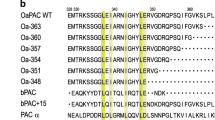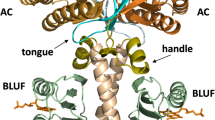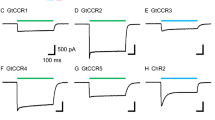Abstract
ONE of the many metabolic functions attributed to adenosine 3′:5′-cyclic monophosphate (cyclic AMP) is that of a mediator in the responses of living organisms to light stimulation. It has been associated with dopaminergic synaptic activities and also with the primary visual process in the retina. In the rod outer segments of the frog, Rana pipiens, cyclic AMP concentrations are diminished by illumination. Regulation is through the cyclic nucleotide phosphodiesterase1. In addition, an adenyl cyclase has been isolated from retina which is activated by the catecholamine dopamine; dopamine is thought to be an important neurotransmitter in the retina2. The exact relationship between the initial transduction of the light signal and the attenuation in the levels of cyclic AMP is unknown. One reason for this is the complexity of the tissue and the difficulty of isolating clean fractions. I describe here a simpler system in which levels of cyclic AMP decrease in response to light stimulation much as in retina and where all the transduction occurs within a single cell.
This is a preview of subscription content, access via your institution
Access options
Subscribe to this journal
Receive 51 print issues and online access
$199.00 per year
only $3.90 per issue
Buy this article
- Purchase on Springer Link
- Instant access to full article PDF
Prices may be subject to local taxes which are calculated during checkout
Similar content being viewed by others
References
Miki, N., Keirns, J. J., Marcus, F. R., Freeman, J., and Bitensky, M. W., Proc. natn. Acad. Sci. U.S.A., 70, 3820–3824 (1973).
Brown, J. H., and Makman, M. H., Proc. natn. Acad. Sci. U.S.A., 69, 539–543 (1972).
Bergman, K., Burke, P. V., Cerdá-Olmedo, E., David, C. N., Delbrück, M., Foster, K. W., Goodell, E. W., Heisenberg, M., Meissner, G., Zalokar, M., Dennison, D. S., and Shropshire, jun., W., Bact. Rev., 99–157 (1969).
Foster, K. W., and Lipson, E. D., J. gen. Physiol., 62, 590–617 (1973).
Bergman, K. A., Eslava, A. P., and Cerdá-Olmedo, E., Molec. gen. Genet., 123, 1–16 (1973).
Shropshire, W., jun., and Bergman, K., Plant Physiol., 43, 1317–1319 (1968).
Brown, B. L., Albana, J. D. M., Ekins, R. P., and Sgherzi, A. M., Biochem. J., 121, 501–502 (1971).
Gilman, A. G., Proc. natn. Acad. Sci. U.S.A., 67, 305–312 (1970).
Goridis, C., and Virmaux, N., Nature, 248, 57–58 (1974).
Brooker, G., Thomas, L. J., jun., and Applemen, M. M., Biochemistry, 7, 4177–4181 (1968); Brooker, G., Adv. Cyclic Nucleotide Res., 2, 111–118 (1972).
Bǎr, H. P., and Hechter, O., Analyt. Biochem., 29, 476–489 (1969).
Lowell, S. L., and Whitfield, M., J. Hist. Cytochem., 873–879 (1972).
Author information
Authors and Affiliations
Rights and permissions
About this article
Cite this article
COHEN, R. Cyclic AMP levels in Phycomyces during a response to light. Nature 251, 144–146 (1974). https://doi.org/10.1038/251144a0
Received:
Issue Date:
DOI: https://doi.org/10.1038/251144a0
This article is cited by
-
Filamentous ascomycetes fungi as a source of natural pigments
Fungal Biology and Biotechnology (2017)
-
Inhibition of phototropism inPhycomyces sporangiophores by calmodulin antagonist and antimicrotubular agents
Current Microbiology (1989)
-
Effect of irradiation with monochromatic visible light on cAMP content in Chinese hamster fibroblasts
Il Nuovo Cimento D (1987)
-
A new allele with abnormal cyclic-AMP phosphodiesterase activity in Phycomyces
Molecular and General Genetics MGG (1985)
-
Cyclic AMP level in relation to different conditions of sporulation rhythm regulation in Leptosphaeria michotii (West) Sacc
Archives of Microbiology (1981)
Comments
By submitting a comment you agree to abide by our Terms and Community Guidelines. If you find something abusive or that does not comply with our terms or guidelines please flag it as inappropriate.



